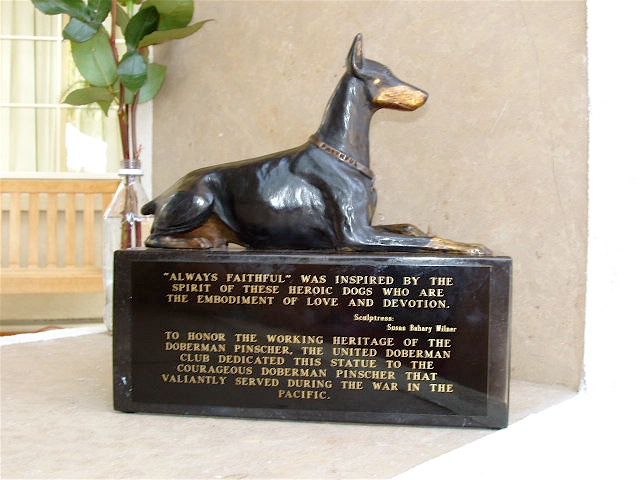ALWAYS FAITHFUL
Our Country’s First Official War Dog Memorial


They served as sentries, messengers, and scouts. They explored caves, and detected mines and booby traps. Given in their memory and on behalf of the surviving men of the 2nd and 3rd Marine War Dog Platoons, many of whom owe their lives to the bravery and sacrifice of these gallant animals.
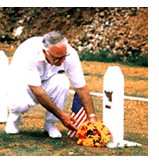 Always Faithful was inspired by the spirit of the heroic war dogs who are the embodiment of love and devotion. The United Doberman Club dedicated Always Faithful to the courageous Doberman Pinschers that served during in the Pacific during WWII. The United Doberman Club-sponsored bronze was created by Susan Bahary and placed at the United States Marine Corps War Dog Cemetery in Guam on June 20, 1994. Many, many special thanks go to the late Dr. William D. Putney and the United Doberman Club for making this all happen!
Always Faithful was inspired by the spirit of the heroic war dogs who are the embodiment of love and devotion. The United Doberman Club dedicated Always Faithful to the courageous Doberman Pinschers that served during in the Pacific during WWII. The United Doberman Club-sponsored bronze was created by Susan Bahary and placed at the United States Marine Corps War Dog Cemetery in Guam on June 20, 1994. Many, many special thanks go to the late Dr. William D. Putney and the United Doberman Club for making this all happen!
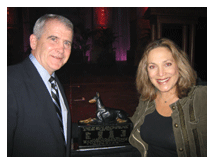 Among Ms. Bahary’s commissions is the first U.W. war dog memorial, Always Faithful, which was featured on CNN and unveiled at the Pentagon in 1994. Always Faithful is permanently installed at the U.S. Marine Corps War Dog Cemetery in Guam and was replicated in 1998 at the University of Tennessee’s College of Veterinary Medicine in Knoxville as a permanent memorial in honor of the war dogs, their handlers, and the veterinary profession, and to the unique human bond with “man’s best friend.” It was replicated again in October 2001 at The Alfred M. Gray Marine Corps Research Center-the university and conference center for the Marine Corps in Quantico, Virginia. In addition, a casting of the monument was installed as a centerpiece of the Centennial Garden at Auburn University College of Veterinary Medicine, Auburn Ala in 2005.
Among Ms. Bahary’s commissions is the first U.W. war dog memorial, Always Faithful, which was featured on CNN and unveiled at the Pentagon in 1994. Always Faithful is permanently installed at the U.S. Marine Corps War Dog Cemetery in Guam and was replicated in 1998 at the University of Tennessee’s College of Veterinary Medicine in Knoxville as a permanent memorial in honor of the war dogs, their handlers, and the veterinary profession, and to the unique human bond with “man’s best friend.” It was replicated again in October 2001 at The Alfred M. Gray Marine Corps Research Center-the university and conference center for the Marine Corps in Quantico, Virginia. In addition, a casting of the monument was installed as a centerpiece of the Centennial Garden at Auburn University College of Veterinary Medicine, Auburn Ala in 2005.
 A life-size bronze Always Faithful also is in the permanent collection of the AKC Museum of the Dog in St. Louis, Mo. The sculpture and its story have been featured for years in major media, including on the national TV program Picture This America, on the Discovery Channel in the Animal Legends series and on Fox News.
A life-size bronze Always Faithful also is in the permanent collection of the AKC Museum of the Dog in St. Louis, Mo. The sculpture and its story have been featured for years in major media, including on the national TV program Picture This America, on the Discovery Channel in the Animal Legends series and on Fox News.
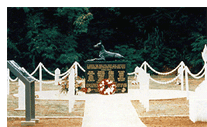 It was a tremendous honor to create Always Faithful to pay tribute to our heroic war dogs and their courageous handlers. I cannot thank our veterans enough for all the sacrifices they have made and continue to make for us. I am very touched by the appreciation that veterans, dog enthusiasts and other people from all walks of life have shown through the years for this memorial.
It was a tremendous honor to create Always Faithful to pay tribute to our heroic war dogs and their courageous handlers. I cannot thank our veterans enough for all the sacrifices they have made and continue to make for us. I am very touched by the appreciation that veterans, dog enthusiasts and other people from all walks of life have shown through the years for this memorial.
General Carl Epting Mundy, Jr., 30th Commandant of the Marine Corps, donated an original casting of the “Always Faithful” monument that stands at the Naval Base Guam, to the Marine Corps Heritage Foundation in 2012. The sculpture features Kurt the Doberman, the first military working dog killed in action in the 1944 Battle of Guam, during World War II. Military working dogs provided an enormous service to World War II Marines, with some making the ultimate sacrifice while protecting troops. The “Always Faithful” statue was first commissioned by the United Doberman Club along with a Marine Corps officer who went on to serve as a well-known veterinarian to the famous dogs of the Hollywood screens, such as Rin Tin Tin. The monument, by internationally noted sculptor Susan Bahary, is now located in Semper Fidelis Memorial Park adjacent to the National Museum of the Marine Corps.
“We are so pleased that General Mundy donated an original casting of the ‘Always Faithful’ monument to be placed in Semper Fidelis Memorial Park,” said LtGen Robert Blackman, Jr., president and CEO of the Marine Corps Heritage Foundation. “War dogs served valiantly as part of Marine Corps operations throughout World War II. We are proud to honor their service and the service of all military working dogs throughout Marine Corps history. Visitors to the Marine Corps Heritage Center will now be reminded and have the opportunity to reflect on the dogs’ contributions to our nation and honor their memory.”
“I donated the statue to be placed in Semper Fidelis Memorial Park where it can be seen and appreciated by the public for years to come,” said Mundy. “During my career, I witnessed the special bond between handlers and their dogs, and what a central role the dogs played in helping and protecting our service members. The statue is meant to recognize all the dogs that have served our nation and Marines so faithfully, and I wanted the American public to know more about their contributions.”
The United States Marine Corps began using military working dogs, then known as “war dogs,” during World War II. During the Battle of Guam, Marines used the working dogs, mostly Dobermans and German Shepherds, as sentries, messengers and scouts. From carrying messages and medical supplies, to sniffing out hiding enemy soldiers and warning of forthcoming attacks, the dogs served alongside the Marines, even sleeping in the foxholes with their handlers. Twenty-five Marine war dogs lost their lives during the battle.
 Kurt, the first dog killed, was among the war dogs who helped save the lives of many Marines by silently warning the troops of an upcoming attack by 5,000 Japanese soldiers. He was badly injured by the Japanese mortar and grenade attack. Kurt’s handler, Private 1st Class Allen S. Jacobson was also wounded, but would not accept treatment until Kurt was carried to the rear. Kurt died in the arms of 1stLt William Putney, a veterinarian and the commanding officer of the 3rd War Dog Platoon during the Battle of Guam, who tried to save him. Kurt and the dogs killed in action were buried in a portion of the temporary Marine cemetery on the island, with one buried at sea. Later, headstones were added to the dogs’ graves.
Kurt, the first dog killed, was among the war dogs who helped save the lives of many Marines by silently warning the troops of an upcoming attack by 5,000 Japanese soldiers. He was badly injured by the Japanese mortar and grenade attack. Kurt’s handler, Private 1st Class Allen S. Jacobson was also wounded, but would not accept treatment until Kurt was carried to the rear. Kurt died in the arms of 1stLt William Putney, a veterinarian and the commanding officer of the 3rd War Dog Platoon during the Battle of Guam, who tried to save him. Kurt and the dogs killed in action were buried in a portion of the temporary Marine cemetery on the island, with one buried at sea. Later, headstones were added to the dogs’ graves.
After the war, Putney was instrumental in ensuring most of the 549 war dogs were successfully retrained so they could return to the States as domestic pets. While Putney went on to become a successful Hollywood veterinarian, he never forgot the war dogs and devoted his life to making sure they were remembered.
Putney returned to Guam in the late 1980’s to find that the cemetery where the war dogs had been buried had been moved and was ill-kempt. He helped raise funds to have the dogs properly buried, and The National War Dog Cemetery was opened at the U.S. Naval Base at Orote Point. Putney along with the United Doberman Club worked to raise funds to commission the “Always Faithful” monument in honor of the dogs who lost their lives liberating Guam.
In addition to the Naval Base at Guam, castings of the “Always Faithful” monument can also be found at Auburn University College of Veterinary Medicine, Auburn, Ala.; the University of Tennessee’s College of Veterinary Medicine in Knoxville; and The Alfred M. Gray Marine Corps Research Center in Quantico, Va.; The American Kennel Club Museum of the Dog; and in private collections. Nine castings of the monument exist, in addition to the artist’s proof. Putney was a graduate of Auburn University, as is Mundy.
“I couldn’t be more thrilled with the placement of ‘Always Faithful’ at the National Museum of the Marine Corps, where it can be seen by so many civilians as well as those in the military,” said sculptor Susan Bahary. “It is especially meaningful and fitting that is was donated by General Carl E. Mundy who as the Commandant of the Marine Corps, officiated at the first unveiling of the monument in Guam in 1994. He has continued to be a great supporter of the sculpture and the valiant war dog handlers and their dogs.”
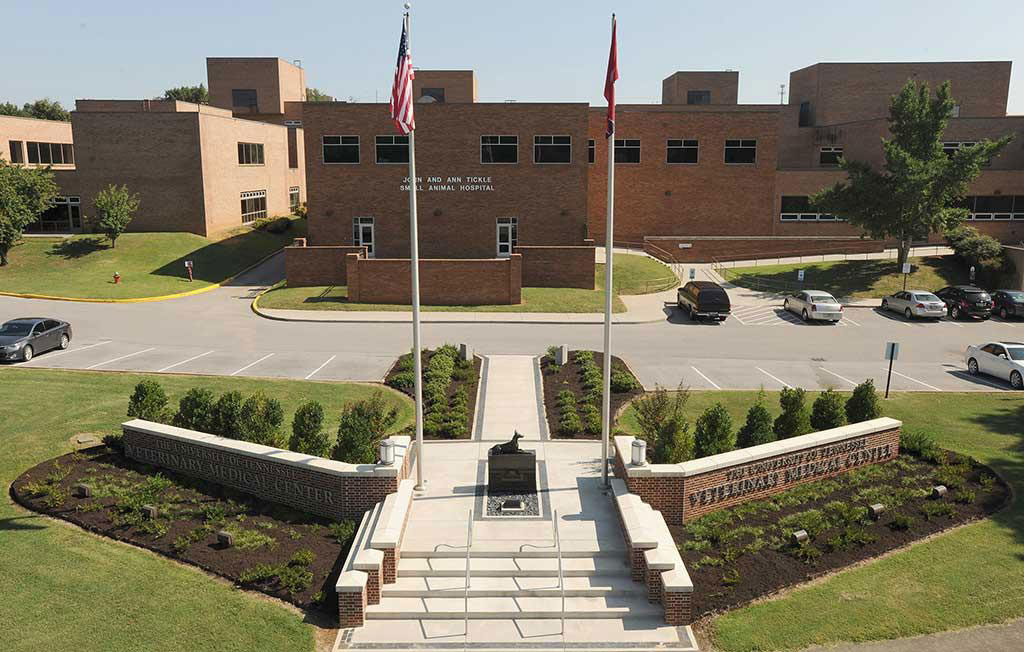

University of Tennessee Veterinary School Knoxville, TN
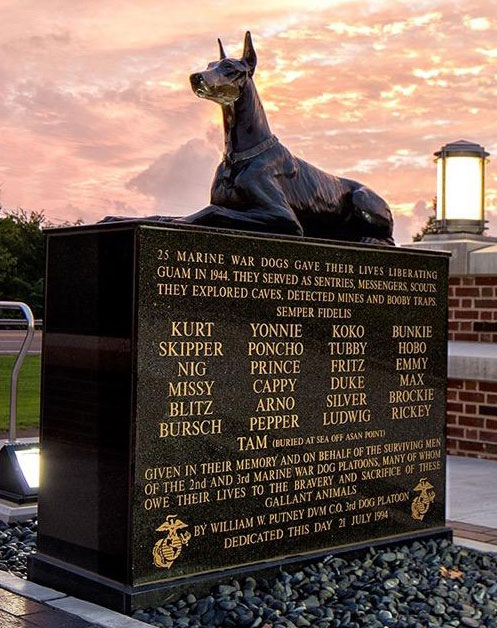
Table-Top Version of Always Faithful
Bronze on granite base with engraved brass plaques
Edition 195
Dimensions: 11 H x 12 W x 4 D
Shown Below
